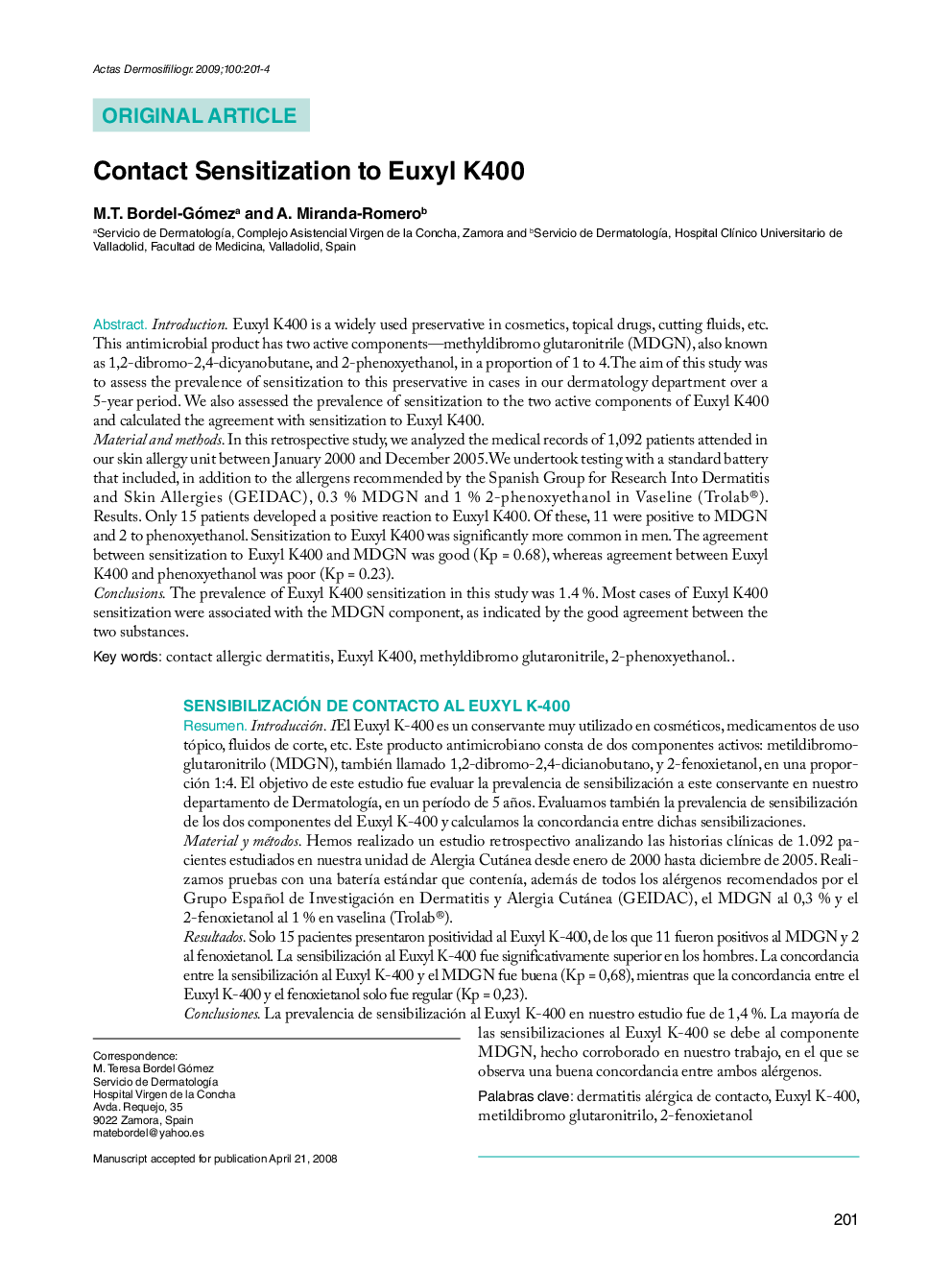| کد مقاله | کد نشریه | سال انتشار | مقاله انگلیسی | نسخه تمام متن |
|---|---|---|---|---|
| 3184149 | 1200733 | 2009 | 4 صفحه PDF | دانلود رایگان |

IntroductionEuxyl K400 is a widely used preservative in cosmetics, topical drugs, cutting fluids, etc. This antimicrobial product has two active components—methyldibromo glutaronitrile (MDGN), also known as 1,2-dibromo-2,4-dicyanobutane, and 2-phenoxyethanol, in a proportion of 1 to 4.The aim of this study was to assess the prevalence of sensitization to this preservative in cases in our dermatology department over a 5-year period. We also assessed the prevalence of sensitization to the two active components of Euxyl K400 and calculated the agreement with sensitization to Euxyl K400.Material and methodsIn this retrospective study, we analyzed the medical records of 1,092 patients attended in our skin allergy unit between January 2000 and December 2005.We undertook testing with a standard battery that included, in addition to the allergens recommended by the Spanish Group for Research Into Dermatitis and Skin Allergies (GEIDAC), 0.3% MDGN and 1% 2-phenoxyethanol in Vaseline (Trolab®).ResultsOnly 15 patients developed a positive reaction to Euxyl K400. Of these, 11 were positive to MDGN and 2 to phenoxyethanol. Sensitization to Euxyl K400 was significantly more common in men. The agreement between sensitization to Euxyl K400 and MDGN was good (Kp = 0.68), whereas agreement between Euxyl K400 and phenoxyethanol was poor (Kp = 0.23).ConclusionsThe prevalence of Euxyl K400 sensitization in this study was 1.4%. Most cases of Euxyl K400 sensitization were associated with the MDGN component, as indicated by the good agreement between the two substances.
ResumenIntroducciónIEl Euxyl K-400 es un conservante muy utilizado en cosméticos, medicamentos de uso tópico, fluidos de corte, etc. Este producto antimicrobiano consta de dos componentes activos: metildibromoglutaronitrilo (MDGN), también llamado 1,2-dibromo-2,4-dicianobutano, y 2-fenoxietanol, en una proporción 1:4. El objetivo de este estudio fue evaluar la prevalencia de sensibilización a este conservante en nuestro departamento de Dermatología, en un período de 5 años. Evaluamos también la prevalencia de sensibilización de los dos componentes del Euxyl K-400 y calculamos la concordancia entre dichas sensibilizaciones.Material y métodosHemos realizado un estudio retrospectivo analizando las historias clínicas de 1.092 pacientes estudiados en nuestra unidad de Alergia Cutánea desde enero de 2000 hasta diciembre de 2005. Realizamos pruebas con una batería estándar que contenía, además de todos los alérgenos recomendados por el Grupo Español de Investigación en Dermatitis y Alergia Cutánea (GEIDAC), el MDGN al 0,3% y el 2-fenoxietanol al 1% en vaselina (Trolab®).ResultadosSolo 15 pacientes presentaron positividad al Euxyl K-400, de los que 11 fueron positivos al MDGN y 2 al fenoxietanol. La sensibilización al Euxyl K-400 fue significativamente superior en los hombres. La concordancia entre la sensibilización al Euxyl K-400 y el MDGN fue buena (Kp = 0,68), mientras que la concordancia entre el Euxyl K-400 y el fenoxietanol solo fue regular (Kp = 0,23).ConclusionesLa prevalencia de sensibilización al Euxyl K-400 en nuestro estudio fue de 1,4%. La mayoría de las sensibilizaciones al Euxyl K-400 se debe al componente MDGN, hecho corroborado en nuestro trabajo, en el que se observa una buena concordancia entre ambos alérgenos.
Journal: Actas Dermo-Sifiliográficas (English Edition) - Volume 100, Issue 3, 2009, Pages 201-204